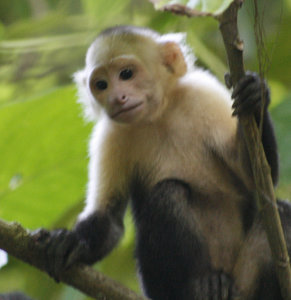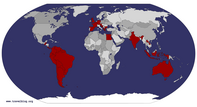Advertisement
Published: August 23rd 2015

 Inquisitive Spider monkey
Inquisitive Spider monkey
Corcovado National Park, Costa RicaWe spent the day at and around the research station and the Corcovado national park. After a night of exhaustion sleep, broken by restless periods due to the heat, we started our first walk at 0430. This was pre dawn and the light built quickly. We were fortunate that few people slept at the station on the previous night, so there was nobody else on the trails. Wildlife viewing started almost as soon as we left the clearing around the station and entered the jungle. Nito was great at spotting wildlife or identifying places where the action might happen. He found:
• Tiny bats and frogs in strange places like under palm fronds and inside newly-opened banana leaves;
• Copulating lizards and huge cockroaches.
• Army and leaf-cutter ants and their nests. The Army ant nest was actually a gathered mass of ants around a queen tending larvae, workers and soldiers. The soldiers sensed our presence and came at us with a vengeance. The leaf-cutter ants built a large underground pueblo that include "farmed fungus" for composting the leaves.
Nito knew the good spots. SW toward the beach, which was inaccessible due to the high tides, was a saline
swampy area. He took us back there twice to look at an adult tapir dozing in the mud. He/she was well camouflaged and when my eyes finally saw the pattern of his outline it was surprising just how close we were to him. When one thinks about the rest of the forest, a swamp must be a place of relatively few annoyances. He/she looked very calm. Nito was also casting a telescope on a tripod. This allowed us an excellent view of birds he would spot or whistle in to see us. The telescope also accommodated our little Leica so some excellent shots were captured. We were probably back to the station by 0730 and then proceeded to prepare a simple breakfast and boil up water for the subsequent day's exit. We dozed and read on the big verandas of the station during the heat of the day.
We were out again between 9-11 with a focus more on the wet areas that were inaccessible earlier in the day due to the tides. Again our guide did a great job. All four of us were experiencing some physical results of our hike in on the previous day. I had
pain on the bottom of my feet; Catherine had back pain and feet issues; Wendell had blisters; and Bill was experiencing a tightness in the lower back which has been with him for years. We called ourselves "the pensioners" portentiously.
We headed out again around 1530. Nito guided us back along the path we had come in on. With more time and less exhaustion we saw a cayman, caracaras, large turkey-like birds (curassows) and of course Nito tormented the spider monkeys by shaking trees and barking at them. We ended up back at the river crossing that caused stress the previous day. We say other groups negotiating the crossing with water further up their bodies than in our cases. The same small crocodile cruised nearby. Nito helped us photograph vultures that were sitting on one of the sand banks. He also spotted an Amazonian Kingfisher which is rare in the park. We talked about the logistics of the homeward walk and this crossing early the next morning, especially how the tides would affect the river and beach crossings. During the day we had also seen the landing place for boats from Drake Bay. That would have been a much
less stressful way of experiencing Sirena. Oh well. Almost suddenly the clouds gathered for an approaching thunderstorm. The vultures lifted off and rode the thermals far above us. We headed back to Sirena through progressively heavier rain. It cooled the temperature for some limited time. It began to pour. We watched more groups walking in through the drizzle including a 50 plus year old large American and his son who came in after 1900 having come across the river in the day with packs above their heads: clearly exhausted. We subsequently learned he is a biologist and was trying to carry in a number of textbooks, presumably to identify some new plants, animals or other orders. The guide had to run back the next day and pick up the half of the gear they jettisoned along the way. Lots more people sleeping on the Sirena decks this night. Despite the rain, the humidity and heat made sleep difficult. We grabbed what sleep we could, knowing we would have a 0400 rise. Another group noisily departed the site at about 0230!
Walked out of Sirena and back to Carate. We were walking by 0430. This time we went straight to

 Frog inside a banana leaf
Frog inside a banana leaf
Corcovado National Park, Costa Ricathe end of the cleared landing strip in the dark to minimise the chances of meeting a 'fer de lance' - a highly venomous and well camouflaged snake. As it was we did see one of the twig-scaled buggars, and it was only Nito's head lamp and acute eyes that stopped a closer encounter.
On the way out we talked with Nito about the species we saw. We made a bit of a list which is probably incomplete. As we subsequently found out, Corcovado is regarded as one of the most biodiverse places on earth. We saw: tapir; karate; air-eaters; squirrel monkeys; spider monkeys; howler monkeys; crocodiles; Cayman; red squirrel; peccaries. Among the birds there were: tiger heron; black hawk eagle; crested caracara; several types of vulture; crested guan, great curassow; great tinamou; various doves and pigeons; scarlet macaws; pauraque; some owls; mangrove swallows; hummingbirds (though not by me on that occassion); keel-billed toucans; keel-billed motmot; green or Amazon kingfisher; ringed kingfisher; Inca tern, sandpiper; pale-billed woodpecker, mountain trogon; several wood creepers; bare crowned antbird; various thrushes and wrens, various yellow orioles; yellow-throated euphonia; other tanagers; various finches though they were difficult to spot. An amazing array of wildlife

 Keel-billed Motmot
Keel-billed Motmot
Corcovado National Park, Costa Ricaand I have said nothing about the enormous subset of fungi and plants. Amazing diversity, which meant the drudgery of the walk was broken often.
Still there's no misstating it, the walk out was hard. Each one of us had some legitimate complaint, and the conversations dropped out toward the finish. Finally back to the start where the taxi driver provided cold watermelon. Bill and I took cold coconut water as well. We saw people who were on half-day walks into the park, and we're glad we had done the whole thing. The taxi ride back was rough and long. The rain had deepened some potholes. From this side of the road I could see some of the renown surf beaches. Captain Goodvibes dream world (ref. Tracks magazine circa, 1973). A quick net search will turn up some classic memories. Surreal stuff.
Back to the rooms in Puerto Jimenez to de-louse etc. Dinner was at a very local Italian place. We did not take Nito's recommendation because the extra 100 m walk would have killed us.
We left Puerto Jimenez by hire car, and intending to head generally to the NW. Local community political activists had blockaded

 Howler monkey and baby
Howler monkey and baby
Corcovado National Park, Costa Ricathe only bridge at Palmer Sur. it was a struggle between the countries elite pushing poorer folk off their land. We drove up close to the blockage and talked with locals to get the story. Local vendors were taking advantage of the long-line of heavy vehicles that no option but to wait. One guy was selling local fruit which we told him, through Bill of course, that they were imported Indonesian lychees. Ultimately we decided to take the 180 km detour across mountains to get back to Palmer Norte: the other side of the Palmer river. It turned out we enjoyed seeing new country in the rugged interior of Costa Rica, including a road that climbed stunningly fast up to a 1500m plateau. Ate well in San Vito where we noted the greater number of Mayan people, at least compared with coastal Costa Rica.
On the way up the coast we checked out the surfer haven of Playa Dominical. This was very groovy with a simple beach break. Nothing special on the day but we could imagine something more. Finding accommodation was difficult because it was the start of a weekend, and we didn't want to go too shoe-string.

 Seething mass of an Army ant nest
Seething mass of an Army ant nest
Corcovado National Park, Costa RicaWe ended up at the Mamos Hotel in Manuel Antonio which is hillside resort with multiple pools, and room flooring like a cave. Fifty seventh birthday dinner for Greg was pork ribs and the local beer: Imperial a non-description lager like Beer Lao and Belikan in Belize. We enjoyed beers around the pool before bed.
We rose at about 0730 and had breakfast at the hotel. I asked for soft boiled eggs, which I regretted for the rest of the day thinking about chicken pathogens in uncontrolled developing world production systems. But all OK - wasted worry. Down to the Manuel Antonio beach. A guy rented us a sun shelter so then we just swam for an hour or so. Very stony beach but not sharp. Strong surf with a very short ride. The old lady in front of us on the beach had her own chair, "tuckshop arms" and an obvious intent to be there many hours. Apparently this southern end of the beach had only recently become clothed and accepting of diverse and heterosexual orientations. Eventually we had to return to the Mamos Hotel for one more swim and rapid departure. The trip up to San Jose

 White-nosed coati family
White-nosed coati family
Corcovado National Park, Costa Ricainternational airport was relatively simple as we retraced our steps along the coast road. We did stop at the bridge at Tarcoles to see the crocodiles cruising below us. At least 38 big guys were in view casually sunning themselves. The crowds were excited. The crocs exerted themselves just enough to hold their positions against the rivers current. Also past the larger Costa Rican beach resorts, which I must say, held little attraction. We also found the correct freeways this time past San Jose and Alajuela. The little SUV had its work cut out for it as the terrain was hilly and the air hot. Out of San Jose airport with no big deals, except for a tropical downpour.
Advertisement
Tot: 0.108s; Tpl: 0.015s; cc: 12; qc: 29; dbt: 0.0618s; 1; m:domysql w:travelblog (10.17.0.13); sld: 1;
; mem: 1.1mb





















